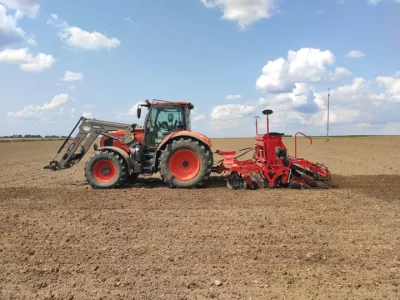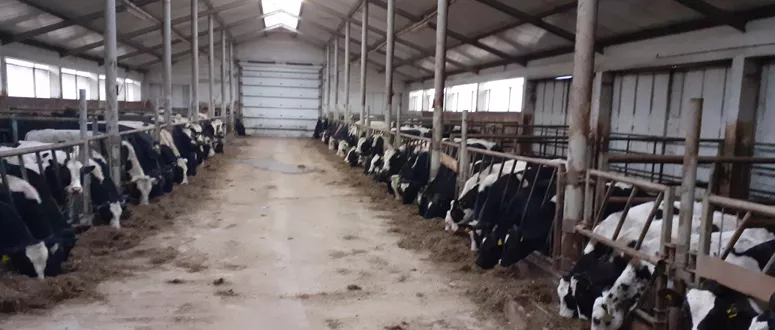General information
RDP Priority
- P2. Competitiveness
RDP Focus Area
- 2A: Farm’s performance, restructuring & modernisation
RDP Measure
- M04: Investments in physical assets
Beneficiary type
- Farmer / land manager
Summary
It is becoming more and more difficult to run small farms focused on pig breeding. This is primarily due to increasingly limited profit margins and external factors such as the spread of African Swine Fever (ASF). Farmers must therefore make careful decisions about the type and scale of their farming activity to ensure sales growth and cost reduction. One of the options available to them is diversified breeding production so that in any given period, the business focus can shift to the area with the greatest profitability potential.
Two farms, both focused primarily on pig farming, made a joint application for CAP investment support in order to construct a modern building for beef cattle. This allowed them to safely and efficiently house a herd of 120 animals. Additionally, the acquisition of new machinery has enabled significant mechanisation, which further increases profitability through labour efficiency.
Results
- The construction of a new barn enabled a significant expansion in the scale of operations, which has reduced production costs.
- Thanks to the new machinery, higher plant yields and better work efficiency are helping to boost profitability.
- The financial losses in pig production are now compensated by the profits from cattle breeding.

Promoter
Paweł Psiuk and Piotr Psiuk
Funding
Total budget: 1 740 490 (PLN)
RDP support: 1 000 000 (PLN)
National/Regional: 740 490 (PLN)
Resources
Documents
Context
Paweł and Piotr run neighbouring farms in Wielki Łęck, Działdowo County, in Poland. With a combined total area of 35 hectares, the two farms were primarily focused on pig production, using feed from crops grown on the farms and only small quantities of enriched feed mixtures purchased from outside. One farm bred 30 sows, from which the weaners were moved to another farm for rearing, but this type of production was becoming very difficult due to rising costs, low livestock purchase prices and the threat of African Swine Fever (ASF).
The farmers did not want to give up animal production, so they decided to expand their farms by breeding beef cattle on a larger scale. This type of breeding was chosen because it is increasingly profitable and provides a joint activity that would diversify both incomes. They decided to apply for support under measure M04 (investments in physical assets) of the 2014-2020 Rural Development Programme (RDP) to establish a farm for 120 beef cattle. They also planned to increase the combined farm area by purchasing and leasing additional land, which they financed thanks to funding from another measure of the 2014-2020 RDP. The farmers’ funds were used to purchase the cattle.
Objectives
The project aimed to provide a second source of income through diversification due to concerns about pig production in Poland. The main investment was the construction of a building to house 120 beef cattle. This new barn was equipped with modern solutions to mechanise work on the facility. The project also included the purchase of agricultural machinery and a tractor to improve fieldwork on the farm.
Activities
The two farms' entire investment was carried out based on an agreement for the joint use of the new machines and building. The preparation of the funding application required a clear division of tasks and responsibilities, as well as transparent financial calculations. For this, the farmers sought support from an agricultural advisor. During the project, the following activities were implemented:
- Constructing a barn building of 610 m2.
- Purchasing an agricultural tractor.
- Purchasing agricultural machinery, including a fertiliser spreader, a cultivation and sowing unit, an agricultural trailer, a reversible plough and a feed wagon.
Main results
- The construction of a new barn enabled a significant expansion in the scale of operations, which reduced production costs. The building ensures the welfare of 120 cattle and is equipped to minimise human labour.
- Thanks to the new machinery, higher plant yields and better work efficiency are helping boost profitability.
- The profits from cattle breeding now compensate for the financial losses in pig production. In the event of a change in the market, pig production will compensate for losses in cattle breeding.
An immeasurable effect of the project has been the improved cooperation between the farms, which has obvious benefits associated with sharing tasks, responsibilities and risks.
Key lessons
- There are obvious benefits to sharing machines and a tractor on two farms, but all restrictions imposed by the programme requirements and the agreement with the Paying Agency must be observed.
- Thanks to the joint investment implemented by the two farms, this project has made a significant impact. However, joint investments rely upon robust agreements with clearly defined tasks for each partner.
- Despite significant financial investment from both farms, the implementation of this project would not have been possible without the support of CAP funds. However, applying for CAP funds involves a lot of work (e.g., project scoping, analysis, documentation, etc.), all of which have their own costs.
- CAP support should enable investment loans, which are very expensive and difficult to obtain but would help farmers who really want to invest in their own farms.
